With the advent of spring, we get not only warmer weather, better mood, and flowering trees. A period of insects, such as mosquitoes, beetles, and ground bees, comes. Carpenter bees are inherently irreplaceable insects, but, unfortunately, they can do quite a lot of harm to human homes.
When it’s one or two bees, they do not carry real danger. But more often, carpenter bees live in families and can settle in one’s house. Since dead wood is a favorite place for building nests for these insects, they can often be found around summer cottages, wooden houses, fences, telegraph poles, and other buildings.
For carpenter bees, when choosing a place for housing, the proximity and ease of finding food don’t play a significant role because these insects can fly for huge distances in search of nectar. So, if your house is located in a relatively distanced place from fields, you are still under the risk that the bees will find your home the perfect place for their family.
I want to note that the active destruction of wood bees is prohibited. Their population is protected, and adopting radical methods to combat them is not the best way out. However, with my knowledge and experience in the field, I can recommend a few tips on how to ward off these insects. So, what are the ways of getting rid of carpenter bees?
Identifying Carpenter Bees
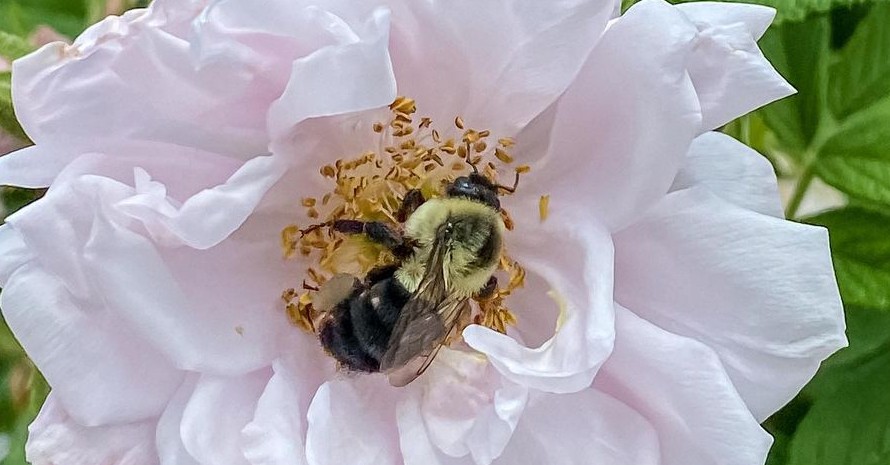
Before taking measures to kill these insects, you need to make sure that you got carpenter bees around your place. Thus, it is essential to learn what do carpenter bees look like. In appearance, a carpenter bee is more like a large hairy fly than a bumblebee in the usual sense.
On pictures of carpenter bees, you may notice a black bee color and iridescent blue-violet glitter wings. Thanks to such a distinctive appearance among the insects, these species are sometimes grouped with purple and blue bees, although, outwardly, they differ exclusively in shades that prevail in the color of the wings.
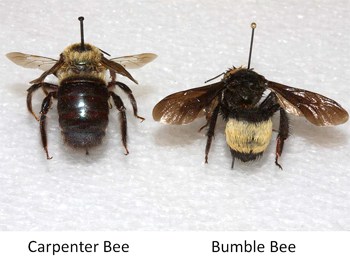
Scientists distinguish more than five hundred different species of carpenter bees, combining them into thirty-one subtypes. These insects got their name because they build nests in dead wood, creating deep multi-level labyrinths with a large number of cells for the development of the larvae.
When gnawing a tunnel, a carpenter bee makes very loud and irritating sounds that remind of the operation of a dental drill. Similar sounds can be heard a few meters from the place where the bee’s main work takes place. These insects make the entrance to their houses perfectly round, and such a hole may even be confused with a specially drilled one.
A carpenter bee creates a nest not only for itself but also for its children, and for several generations and even decades, these species can live in the same place. That’s why carpenter bee prevention is an important task for all people who spotted these insects drilling their houses.

What Attracts Carpenter Bees and What Types of Wood They Prefer
The destructive activity of a bee family is especially dangerous for wooden buildings. The young generation of bees tends to continue the actions of their predecessors and settles in old nests. These species are not only the bees that eat wood, but they use it as a building material. Moreover, these bees have a good reproductive function. One mature female can reproduce up to six larvae per one warm period. That’s why even a small bee family that moved into your house can grow up in population very fast.
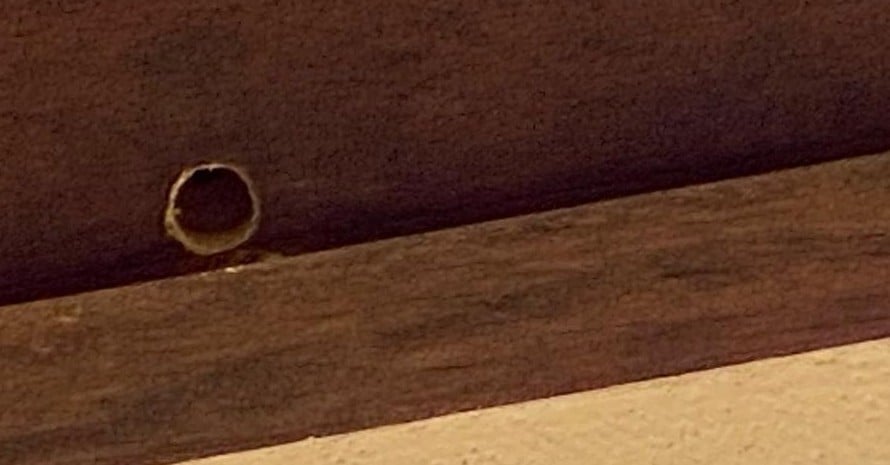
Unlike typical bees, these species do not carry honey to the queen and do not serve her. They live in pairs but in one house and as a large family. Females get food and reproduce offspring, while males guard the nest. Usually, they build nests in old trees, hollows, thickets of bushes, wooden buildings, or country houses.
Also, these bees are a favorite food of woodpeckers. Therefore, if you see such a bird being busy pecking some dead wood, the chances are high that there is a bee nest. The smell of carpenter bee larvae attracts these birds for several kilometers. To get a treat, woodpeckers can hollow out even large carpenter bee holes.
Why Get Rid Of Carpenter Bees
First of all, if a female carpenter bee bites you, you will need to seek help from a specialist urgently, as the sting is very toxic. Such bites are most dangerous for people who are prone to allergic reactions to bee venom. However, these species mostly hide in the nest and don’t fly outside often, so the chance of getting stung is minimal. If it happens, you should immediately consult a doctor.
Males have no stings. Therefore, they are safe for human health and life, but that can’t be said about females. Female carpenter bees are very aggressive, and with a bite, they leave a sting with poison in the human body. A toxic substance causes an allergic reaction of varying degrees of intensity.
Each person has individual characteristics, so it is impossible to predict the body’s response to this poison. An ordinary carpenter bee stings quite painfully. Thus, getting a bee sting is always accompanied by sharp pain and redness of the place where the insect left a bite. Besides, the affected area of the skin may swell, and some people suffer from allergies in the form of rash and itching.
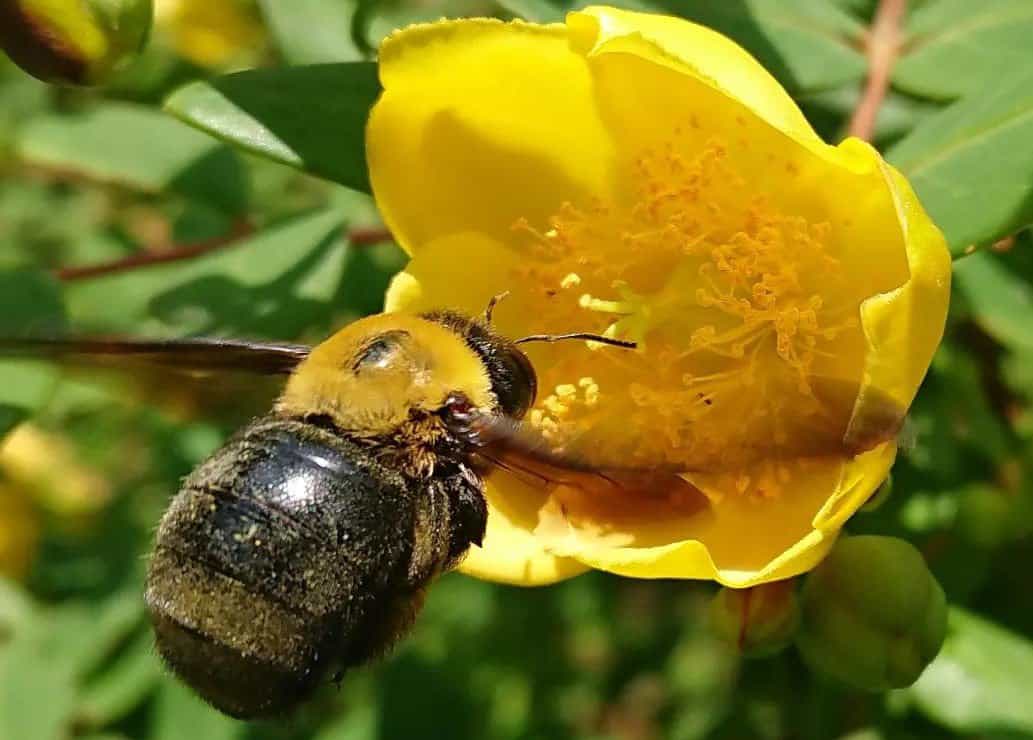
Sometimes, there may be signs, such as a drop in pressure, the appearance of red spots on the body, and respiratory failure. Allergy sufferers are advised to stay away from bees, as bee venom can cause anaphylactic shock and other unpleasant consequences.
The poison introduced into the wound provokes large edema immediately that hurts then for a long time. The active substance has a depressing effect on the central nervous system, and often, there is a nervous shock. If one gets stung in the throat, it might be a deadly danger.
The second reason why you need to get rid of these species as soon as you spot them living in your house is that one female bee lays about six eggs during the entire warm season. Thus, a bee family grows very quickly.
Third, wood bees are very dangerous for your farm buildings. They can destroy structures of any scale, gnawing wide tunnels in them. Bees can ruin even a thick layer of wood in a few years.
Forth, as I have already mentioned, a growing carpenter bee colony is extremely attractive for woodpeckers. The smell of the larvae attracts birds, and they can detect a bee family from several kilometers, flying to the habitat of the insects. Trying to get the larvae, woodpeckers can destroy the structure of a tree or even a wooden wall. Therefore, you need to take measures to eradicate carpenter bees as quickly as possible.
Getting rid of wood bees in a wooden house or on the territory of a summer cottage is somewhat tricky. Insects do not stay into groups, so they have to be destroyed almost one at a time. Here are a few tips on how to get rid of these species from your place.
How To Kill Carpenter Bees
The carpenter bees are very sensitive to noise. Thus, it may be enough to turn on loud music next to the suspected housing of these insects. I recommend playing a composition with low frequencies, meaning turning on a high-quality bass. Carpenter bees themselves will leave their wooden house.
If it doesn’t help, you can remove the unwanted insects with an ultrasonic repeller. With the help of the item, you will make the bees disappear very soon.
Another option is using insecticides. You can use either a powder insecticide for carpenter bees or liquid ones. Make sure not to seal the holes made by bees. Otherwise, these insects will grind out new ways out, thus, avoiding the poison. The only case when you can seal the openings is if you are sure that all the mature species have left the nest.
Carpenter bees most often eat raw wood. But a varnished surface is not what attracts carpenter bees. Already damaged parts of the building can be treated with a spray solution containing citrus oils or pungent herbs.
Related Post: Best Bee Killer Sprays: Safe & Effective Picks
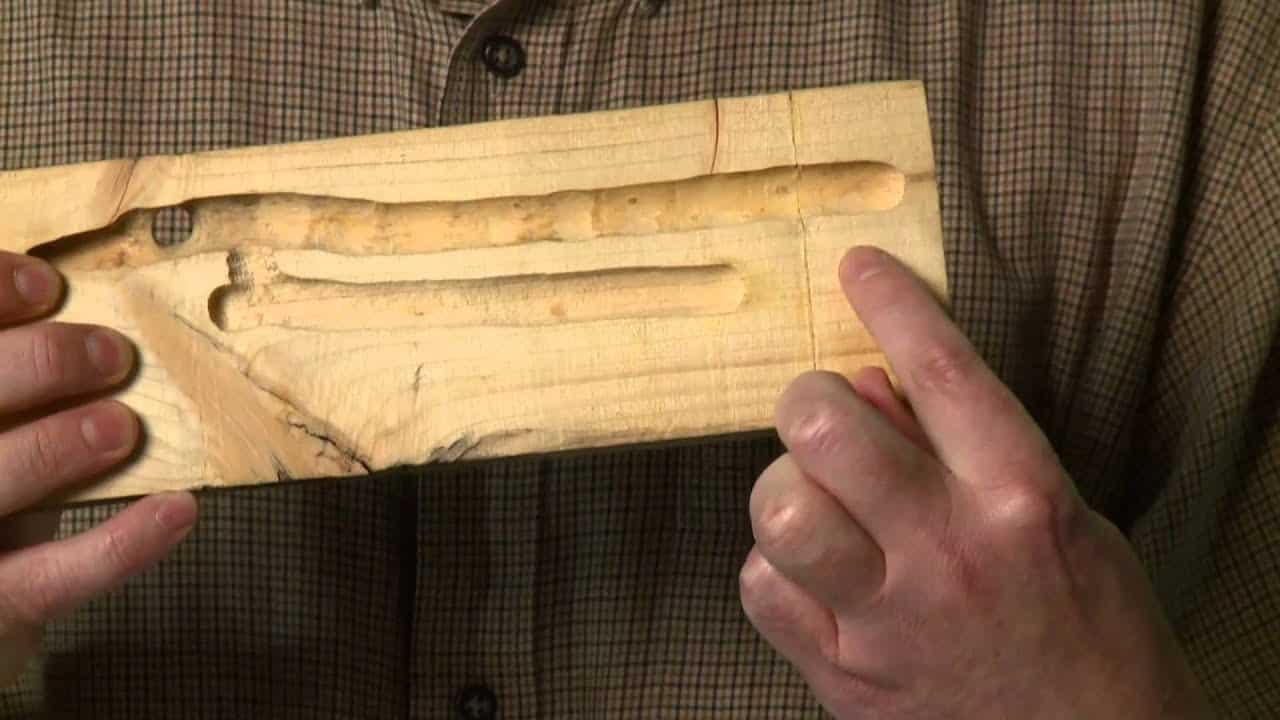
Getting rid of bee larvae is also necessary. For this purpose, you can use special powder insecticides. With these solutions, it is also better not to use liquid products because, as I have said, they are easily absorbed into wooden surfaces. A poisonous powder spreads all over the nest, not closing the exit but working effectively.
If you have just found out about the carpenter bees settling in your house, and they have not managed to create a large nest yet, you can catch them with a standard trap for flying insects that like sweet aromas.
However, although you can use special traps for catching single carpenter bees, some chemical solutions can help to get rid of annoying insects all at once. A pesticide in the form of a spray for carpenter bees can be the most efficient way for carpenter bee extermination and further prevention. These species do not tolerate exposure to powdered pesticides, so the use of such products is quite effective for ruining the nests of these insects. You can apply either boric acid or carbonyl.
I discourage you from buying questionable and unknown pesticides, as they may be dangerous for people, especially children, and also cause irreparable harm to the environment. Before using any pesticide, make sure that you put on all the necessary protective clothing because the female bees will protect the larvae at the cost of their life.
How to Get Rid of Wood Bees without Pesticides
If you don’t want to use pesticides, let me share with you a recipe that proved to work great over the years. You need to fill all the drilled holes of the nest with gas or diesel fuel. Such solutions allow getting rid of wood bees and their larvae easily, but you should be careful when working with gasoline. When applying diesel fuel or gas for carpenter bee control, you need to use personal protective equipment, such as wearing a respirator and protective gloves.
It is best to use an atomizer that can make a gas out of a liquid. If at hand, you have an aerosol cleaner for cars with a carburetor, you can use this tool to get rid of the insects gently. These cleaners are sold in aerosol cans, with elongated tubes for better access to distant places.
This atomizer will help you to spray the liquid into all the holes made by carpenter bees. You need to be very careful when working with this type of solution and make sure that particles of the substance don’t get on your face and in your eyes.
Some other methods that can help you to get rid of wood bees include beekeepers, zappers, and natural remedies. However, from my experience, I can say that these options deliver weaker results than sprays and powders, but still, you can try one of them if you want.
If any of these methods didn’t provide the desired outcome, you should seek help from specialists. If there are several nests and many insects around, you can cope with the problem only by the complex processing and insect elimination. But at the same time, be ready that the structure of the affected building will also suffer because it will be necessary to pick out the honeycombs with larvae.
How to Get Rid of Carpenter Bees Without Killing Them
As I have already mentioned, carpenter bees are extremely sensitive to noise, although they produce one while gnawing new tunnels in their nests. The easiest and quickest way to try to get rid of them is to play loud music, provoking vibrations in the walls or other structures where these bees decided to live. However, even if you drive them out this way, you can’t guarantee that the species will not come back.
To prevent these insects from returning to their nests, you need to take some preventive measures. So, after you have driven out carpenter bees from their nests, cover all the holes with mineral wool, steel wool, or pour foam into the openings. All these solutions are great for sealing holes. Thus, bees wouldn’t be able to re-enter the drilled holes, and those insects remaining inside will die.
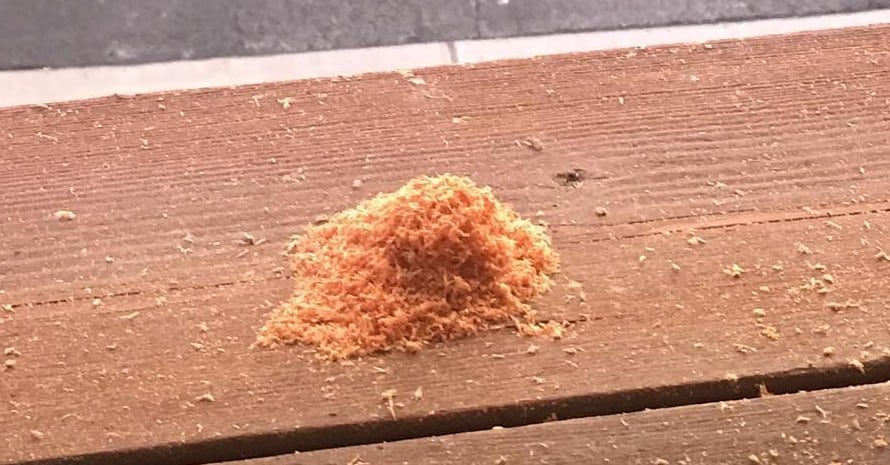
Experienced gardeners know that carpenter bees do not attack wooden exterior surfaces treated with paintwork, as they are more attracted to raw wood. Therefore, I strongly advise painting all the unprocessed areas of your wooden building with varnish or paint.
A citrus carpenter bee repellent is also an effective method to combat the return of carpenter bees. Such citrus-based products can be purchased in specialized garden stores or even made by yourself. You will need to spray the solution into the holes made by carpenter bees, and insects will die. But what’s more important, the genetic code of the carpenter bees will reflect the information that this particular place is unsafe to settle in.
You can also use some special devices to show these insects that it is dangerous to come back. For example, you can turn on a lamp with ultraviolet rays or use an electric trap. In such traps, the current flows through the metal grill. Once the insect approaches the trap and sits on the grate, it receives a deadly shock by the current. Such items are available in many garden shops and can be powered by electricity, batteries, or even gas.
The FAQ on Carpenter Bees
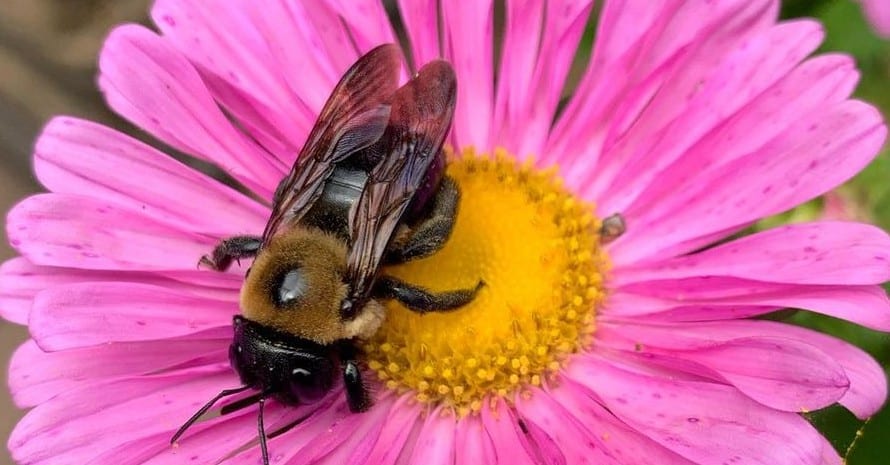
When planning to get rid of these insects, you should know several facts about them. So, I have gathered some common questions on wood bees and tried to answer them in a nutshell.
What Damage Do Wood Boring Bees Cause?
Carpenter bees bring two main dangers. The first one is the poisonous sting that a female bee can leave in your skin with a bite, and it can even have a deadly effect. Second, carpenter bees are destructive to your house if these species select your building for creating their nest. As you now know, wood bees gradually destroy the elements and structure of the house by eating dead wood.
Besides the effect of the carpenter bees themselves, you need to keep in mind that some birds can fly to your home if they smell the bee larvae. The appearance of woodpeckers will also contribute to the destruction of the wooden structures of one’s house.
But even birds can’t cope with a whole bee family because these species of bees reproduce very quickly. During the season, a large number of these insects settle in the walls, thus, being very difficult to get rid of if you do not take measures in time.
What Are the Best Methods of Carpenter Bee Removal?
Carpenter bees can turn your quiet life into a rather big disaster if they decide to settle in the logs of your house. The most popular and easiest way to deal with them is by playing loud music. This method can help if wood bees just appear in the garden, or you have spotted a few drilled holes only. But if they have already settled in your house, getting rid of them will be more difficult.
In this case, music will not work for driving carpenter bees away from your house. Therefore, you need to use special powder pesticides or sprays containing boric acid or carbonyl as carpenter bee treatment to ruin their nests. Also, you can set traps for insects not only near the nests but also all around the building.
How to Protect Wood from Carpenter Bees?
There are many ways of how to stop carpenter bees from settling in your house structures. The problem is that if the insects have already chosen your home, there is a chance that they will return in early spring next year, and everything will start from the very beginning.
That is why it is necessary to take all the measures to protect places that bees consider ideal for nesting, besides your wooden house. I also recommend doing the following:
- Get rid of old and dry trees or logs in your area. Such dead wood attracts carpenter bees in the first place.
Seal all the openings in the ground or trees made by rodents with special solutions. Insects should not have easy access to trees in your yard. - Throw away accumulated debris on time and limit the access of insects to areas with dead wood.
If you do everything so that the carpenter bees can’t accept your trees or stored dead wood that are ideal places for nesting, they will fly away to look for another site.
The smell of paint or polyurethane will confuse and scare away these species. However, even if you paint the trees and wooden surfaces on the outside but do not seal the openings with polyurethane or other suitable solutions, such wood can still attract bees. That’s why I strongly recommend checking wooden parts of your home and trees in your garden attentively and sealing all the holes or openings you spot before covering it with paint or varnish.
How to Get Rid of Carpenter Bees with WD40

If you have a bike, you probably have WD-40 water-displacing spray in your garage. This solution is a universal product to have at home, as it has many applications and works miracles on bees. Thus, if carpenter bees have chosen your wooden construction for building their nests, a WD-40 spray will come in handy.
You need to treat the holes and potential areas for nesting for these insects with this spray once in a couple of days to get rid of the uninvited species forever. However, be ready to smell the solution for weeks after the application, as it has a really strong odor.

Unwanted Neighbors: How to Keep Carpenter Bees Away?
Carpenter bees, or wood bees, are not the most pleasant neighbors. Such bees can easily destroy a wooden structure of one’s house, gnawing tunnels in dead wood for building their nests. Moreover, these insects have a genetic memory that makes the next generations of species return to the places of previous settlement again and again.
That’s why it is necessary to get rid of the carpenter bees in the shortest possible time as you spot them settling in your building. For driving them away from your place, you can use baits, traps, sprays, powder pesticides, and other carpenter bee solutions. Moreover, make sure to take all the preventive measures, such as sealing the openings and treating the wooden parts to avoid any possibility for the carpenter bees to come back to your building.
Do you have a problem with getting rid of the carpenter bees? If yes, what was your experience of driving them out of your wooden building? Is there any method that was not mentioned here but helped you? Let’s find out the best ways to keep these unwanted neighbors away together.

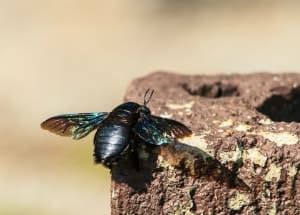
Comments are closed.